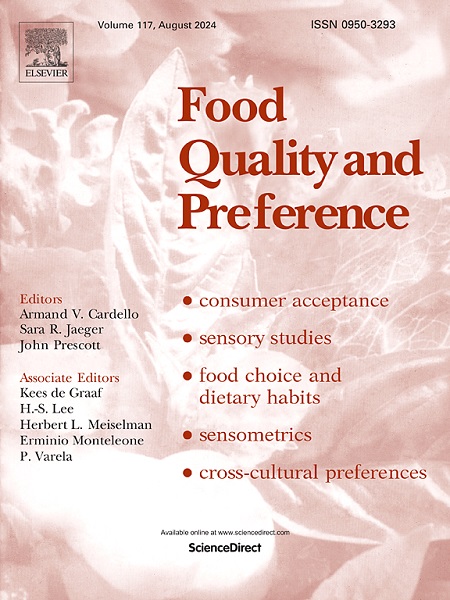鲜味和高味:味精和核苷酸调味料在大酱汤中的作用
IF 4.9
1区 农林科学
Q1 FOOD SCIENCE & TECHNOLOGY
引用次数: 0
摘要
本研究考察了不同的调味料对消费者对大酱汤的厚厚感觉的影响。共有113名参与者完成了一项消费者接受度测试,其中包括喜欢评估和检查所有应用(CATA)问题,以评估感官属性。试验了5种不同的大酱汤:未调味的对照(S1)和含有1%谷氨酸钠(MSG, S2)、1% 5′-肌苷酸二钠(IMP, S3)、1% 5′-鸟苷酸二钠(GMP, S4)和1% 5′-核糖核苷酸二钠(S5)的样品。结果表明,未调味汤(S1)在所有属性中获得的喜欢分数最低(p <;0.05)。不同的调味料对感官的影响不同,以核苷酸为基础的调味料(S3-S5)表现出相似的特征,而味精(S2)则产生更明显的感官效果。对高浓味的正面影响包括鲜味、酱油香气和顺滑的口感,而酸味和酸味则有负面影响。调味料的添加显著增强了鲜味和厚味特征,与核苷酸调味料相比,味精对厚味感知的影响最为显著。本文章由计算机程序翻译,如有差异,请以英文原文为准。
Umami and kokumi: The role of MSG and nucleotide-based seasonings in Doenjang soup
This study examined the impact of different seasonings on the kokumi perception of doenjang soup among consumers. A total of 113 participants completed a consumer acceptance test that included liking assessments and Check-All-That-Apply (CATA) questions to evaluate sensory attributes. Five variations of doenjang soup were tested: an unseasoned control (S1), and samples containing 1 % monosodium glutamate (MSG, S2), 1 % disodium 5′-inosinate (IMP, S3), 1 % disodium 5′-guanylate (GMP, S4), and 1 % disodium 5′-ribonucleotide (S5). Results indicated that the unseasoned soup (S1) received the lowest liking scores across all attributes (p < 0.05). Sensory profiles varied based on seasoning type, with nucleotide-based seasonings (S3-S5) exhibiting similar characteristics, whereas MSG (S2) induced more distinct sensory effects. Positive drivers of kokumi perception included umami, soy sauce aroma, and a smooth mouthfeel, while sourness and tartness had a negative impact. The addition of seasonings significantly enhanced umami and kokumi characteristics, with MSG showing the most pronounced effect on kokumi perception compared to nucleotide-based seasonings.
求助全文
通过发布文献求助,成功后即可免费获取论文全文。
去求助
来源期刊

Food Quality and Preference
工程技术-食品科技
CiteScore
10.40
自引率
15.10%
发文量
263
审稿时长
38 days
期刊介绍:
Food Quality and Preference is a journal devoted to sensory, consumer and behavioural research in food and non-food products. It publishes original research, critical reviews, and short communications in sensory and consumer science, and sensometrics. In addition, the journal publishes special invited issues on important timely topics and from relevant conferences. These are aimed at bridging the gap between research and application, bringing together authors and readers in consumer and market research, sensory science, sensometrics and sensory evaluation, nutrition and food choice, as well as food research, product development and sensory quality assurance. Submissions to Food Quality and Preference are limited to papers that include some form of human measurement; papers that are limited to physical/chemical measures or the routine application of sensory, consumer or econometric analysis will not be considered unless they specifically make a novel scientific contribution in line with the journal''s coverage as outlined below.
 求助内容:
求助内容: 应助结果提醒方式:
应助结果提醒方式:


